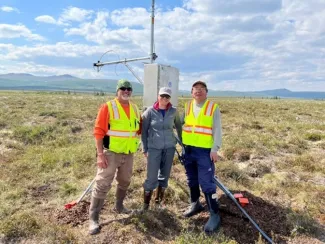Fluorescence automated measurement equipment (FAME) was installed at the NGEE Arctic Council, Alaska site, and a surprisingly strong signal of sun-induced chlorophyll fluorescence (SIF) was obtained.
SIF is emitted from chlorophyll antenna complexes during the light harvesting and photophysical reactions of photosynthesis. It is directly coupled with photosynthetic electron transport and CO2 assimilation and therefore can be used to estimate these behaviors. FAME is an instrument developed by Oak Ridge National Laboratory scientists for continuous, unattended measurements of SIF in challenging field conditions. A FAME unit was installed at the Council site in June 2022 with a footprint overlapping that of the existing eddy covariance system. This overlapping will maximize the synergy between these two data streams for studying the functioning of Arctic tundra. SIF is a light signal from vegetation and superimposed with the reflected solar irradiance from the surface. The presence of SIF is detected by infilling “dark wells” in the reflected spectral radiance. These wells are caused by solar (Fraunhofer lines) and telluric (e.g., oxygen A and B) absorption bands. Data obtained by the FAME at the Council site show a very sharp peak in the apparent reflectance spectra at the oxygen A band, indicating SIF at the Council site is surprisingly strong. This strong SIF signal may suggest high primary growth productivity and/or subdued non-photochemical quenching in this tundra.


